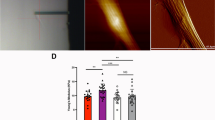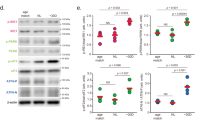Abstract
Background
Many reports have shown that Wnt/β-Catenin pathway is associated with a variety of diseases, but its role in the pathogenesis of myopia is still unknown. In order to clarify the role of Wnt/β-catenin pathway in the development of form deprivation myopia (FDM), this study investigated the expression of scleral Wls, β-catenin and TCF4 in mice model of form deprivation (FD) myopia.
Methods
Three parallel experimental groups, including FD, monocular exposure (SC) and binocular exposure (NC) group, were designed to investigate the effects of Wnt/β-Catenin pathway on scleral remodeling mouse during form deprivation in three-week-old C57BL/6 mice. Diopters and axial lengths (AL) in each sample were measured with an infrared eccentric refractometer or spectral-domain optical coherence tomography. The expression of scleral Wls, β-catenin and TCF4 were detected with Western blot. Morphological changes of posterior sclera were observed with a transmission electron microscope (TEM). The above characterization and analysis were performed on the 0th, 7th, 14th, 21st and 28th days, respectively.
Results
The difference of diopter and AL between the three groups (SC, NC and FD group) gradually increased with the prolongation of FD time (except AL between SC and NC groups). The changes of diopter and AL gradually increased with the prolongation of FD time. Especially, the diopter and AL will increase sharply after FD lasts for a long time, such as the measurement on the 21st for diopter and 28th days for AL. Most notably, the AL of FD eyes significantly increased after 28 days of deprivation. Thinning and disordered arrangement of collagen fibers and a decrease of extracellular matrix were observed with TEM. The expression of scleral Wls, β-catenin and TCF4 increased with age in the NC and SC group. In FD group, they increased significantly on the 7th, 14th and 21st days but decreased on the 28th day.
Conclusions
The expression of Wls, β-Catenin and TCF4 to FD were more sensitive indicators than that of diopter and AL. Within the first 7 days of FD, the expression of Wls, β-Catenin and TCF4 in sclera increased sharply. With the extension of FD duration, it gradually decreased. It is suggested that the Wnt/β-catenin pathway might be involved in the scleral remodeling induced in FDM mice.




Similar content being viewed by others
Data availability
The datasets used and analyzed during the current study are available from the corresponding author on reasonable request.
Abbreviations
- AL:
-
Axial length
- ARVO:
-
Association for research in vision and ophthalmology
- ECM:
-
Extracellular matrix
- FDM:
-
Form deprivation myopia
- NC:
-
Normal control
- SC:
-
Self-control
- TCF4:
-
T cell factor 4
- TEM:
-
Transmission electron microscopy
- Wls:
-
Wntless
References
Saw SM, Gazzard G, Shih-Yen EC, Chua WH (2005) Myopia and associated pathological complications. Ophthalmic Physiol Opt 25(5):381–391
Tong L, Wong EH, Chan YH, Balakrishnan V (2002) A multiple regression approach to study optical components of myopia in Singapore school children. Ophthalmic Physiol Opt 22(1):32–37
Avetisov ES, Savitskaya NF, Vinetskaya MI, Iomdina EN (1983) A study of biochemical and biomechanical qualities of normal and myopic eye sclera in humans of different age groups. Metab Pediatr Syst Ophthalmol 7(4):183–188
McBrien NA, Cornell LM, Gentle A (2001) Structural and ultrastructural changes to the sclera in a mammalian model of high myopia. Invest Ophthalmol Vis Sci 42(10):2179–2187
Curtin BJ, Iwamoto T, Renaldo DP (1979) Normal and staphylomatous sclera of high myopia: an electron microscopic study. Arch Ophthalmol 97(5):912–915
Nusse R, Clevers H (2017) Wnt/beta-catenin signaling, disease, and emerging therapeutic modalities. Cell 169(6):985–999
Niehrs C (2012) The complex world of WNT receptor signalling. Nat Rev Mol Cell Biol 13(12):767–779
Bengoa-Vergniory N, Kypta RM (2015) Canonical and noncanonical Wnt signaling in neural stem/progenitor cells. Cell Mol Life Sci 72(21):4157–4172
Ring A, Kim YM, Kahn M (2014) Wnt/catenin signaling in adult stem cell physiology and disease. Stem Cell Rev Rep 10(4):512–525
Loh KM, van Amerongen R, Nusse R (2016) Generating cellular diversity and spatial form: wnt signaling and the evolution of multicellular animals. Dev Cell 38(6):643–655
Beyer C, Schramm A, Akhmetshina A, Dees C, Kireva T, Gelse K, Sonnylal S, de Crombrugghe B, Taketo MM, Distler O et al (2012) beta-catenin is a central mediator of pro-fibrotic Wnt signaling in systemic sclerosis. Ann Rheum Dis 71(5):761–767
Zhang B, Zhou KK, Ma JX (2010) Inhibition of connective tissue growth factor overexpression in diabetic retinopathy by SERPINA3K via blocking the WNT/beta-catenin pathway. Diabetes 59(7):1809–1816
He W, Dai C, Li Y, Zeng G, Monga SP, Liu Y (2009) Wnt/beta-catenin signaling promotes renal interstitial fibrosis. J Am Soc Nephrol 20(4):765–776
Chua AW, Gan SU, Ting Y, Fu Z, Lim CK, Song C, Sabapathy K, Phan TT (2011) Keloid fibroblasts are more sensitive to Wnt3a treatment in terms of elevated cellular growth and fibronectin expression. J Dermatol Sci 64(3):199–209
Ma M, Zhang Z, Du E, Zheng W, Gu Q, Xu X, Ke B (2014) Wnt signaling in form deprivation myopia of the mice retina. PLoS ONE 9(4):e91086
Tejedor J, de la Villa P (2003) Refractive changes induced by form deprivation in the mouse eye. Invest Ophthalmol Vis Sci 44(1):32–36
Zhou X, Shen M, Xie J, Wang J, Jiang L, Pan M, Qu J, Lu F (2008) The development of the refractive status and ocular growth in C57BL/6 mice. Invest Ophthalmol Vis Sci 49(12):5208–5214
Park H, Qazi Y, Tan C, Jabbar SB, Cao Y, Schmid G, Pardue MT (2012) Assessment of axial length measurements in mouse eyes. Optom Vis Sci 89(3):296–303
Miyagawa A, Kobayashi M, Fujita Y, Nakamura M, Hirano K, Kobayashi K, Miyake Y (2000) Surface topology of collagen fibrils associated with proteoglycans in mouse cornea and sclera. Jpn J Ophthalmol 44(6):591–595
Jonas JB, Wang YX, Dong L, Yin Guo Y, Panda-Jonas S (2020) Advances in myopia research anatomical findings in highly myopic eyes. Eye Vis 7:45
Li M, Yuan Y, Chen QZ, Me R, Gu Q, Yu YJ, Sheng MJ, Ke BL (2016) Expression of Wnt/β-catenin signaling pathway and its regulatory role in type i collagen with TGF-β1 in scleral fibroblasts from an experimentally induced myopia guinea pig model. J Ophthalmol 2016:5126560
Peng MJ, Wei YT, Zhang ZT, Zhang T, Qiu S, Fang D, Wang L (2020) SC: increased levels of DKK1 in vitreous fluid of patients with pathological myopia and the correlation between DKK1 levels and axial length. Curr Eye Res 45(1):104–110
Miyake M, Yamashiro K, Tabara Y, Suda K, Morooka S, Nakanishi H, Khor CC, Chen P, Qiao F, Nakata I et al (2015) Identification of myopia-associated WNT7B polymorphisms provides insights into the mechanism underlying the development of myopia. Nat Commun 6:6689
Li M, Yuan Y, Chen Q, Me R, Gu Q, Yu Y, Sheng M, Ke B (2016) Expression of Wnt/beta-catenin signaling pathway and its regulatory role in type I collagen with TGF-beta1 in scleral fibroblasts from an experimentally induced myopia guinea pig model. J Ophthalmol 2016:5126560
Banziger C, Soldini D, Schutt C, Zipperlen P, Hausmann G, Basler K (2006) Wntless, a conserved membrane protein dedicated to the secretion of Wnt proteins from signaling cells. Cell 125(3):509–522
Huang P, Yan R, Zhang X, Wang L, Ke X, Qu Y (2019) Activating Wnt/beta-catenin signaling pathway for disease therapy: challenges and opportunities. Pharmacol Ther 196:79–90
Brockschmidt A, Filippi A, Charbel Issa P, Nelles M, Urbach H, Eter N, Driever W, Weber RG (2011) Neurologic and ocular phenotype in Pitt-Hopkins syndrome and a zebrafish model. Hum Genet 130(5):645–655
Acknowledgements
The authors thank Professor Renhong Tang for general support.
Funding
This study was supported by Natural Science Foundation of Hunan Province (No. KY030111) and National Natural Science Foundation of China (No. 82071002). However, the funding organization had no role in the design of the study and collection, analysis and interpretation of data or in writing the manuscript.
Author information
Authors and Affiliations
Contributions
Conception and design: DZ, Administrative support: ZD, Collection and assembly of data: SH, Laboratory analysis and interpretation: DZ, SH, Manuscript writing: SO, HL, Final approval of manuscript: All authors.
Corresponding author
Ethics declarations
Competing interests
The authors declare that they have no competing interests.
Ethics approval and consent to participate
All animal experiments were conducted in accordance with the ARVO Statement of Animals in Ophthalmic and Vision Research and approved by the institutional review board (IRB) of the third Xiangya Hospital of Central South University, which have authorization for animal experiments.
Consent for publication
Not applicable.
Additional information
Publisher's Note
Springer Nature remains neutral with regard to jurisdictional claims in published maps and institutional affiliations.
Rights and permissions
About this article
Cite this article
Hu, S., Ouyang, S., Liu, H. et al. The effect of Wnt/β-catenin pathway on the scleral remolding in the mouse during form deprivation. Int Ophthalmol 41, 3099–3107 (2021). https://doi.org/10.1007/s10792-021-01875-1
Received:
Accepted:
Published:
Issue Date:
DOI: https://doi.org/10.1007/s10792-021-01875-1




